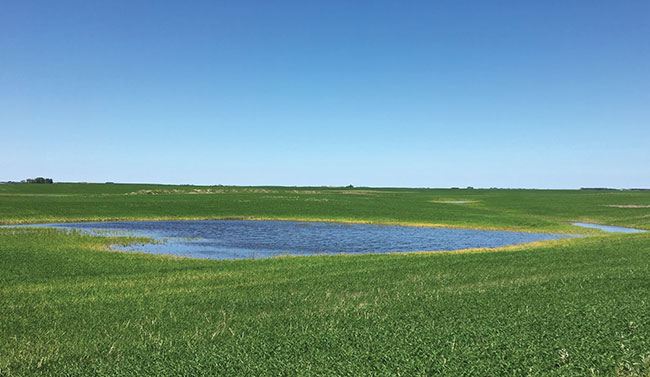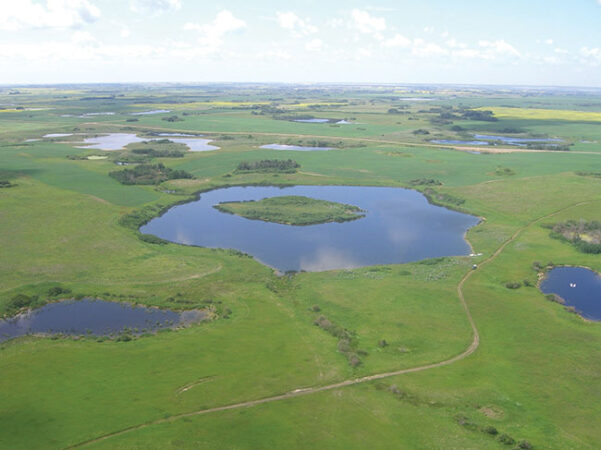
Features
Environment
What’s in a wetland?
More than $2,600 per acre per year in societal value.
June 14, 2023 By Bruce Barker
 Wetlands add immense value to society, but can be costly to farmers.
Photo courtesy of Lisha Berzins /University of Saskatchewan.
Wetlands add immense value to society, but can be costly to farmers.
Photo courtesy of Lisha Berzins /University of Saskatchewan. For many farmers, wetlands are often seen as a nuisance, creating obstacles to farm around, impacting the development of salinity and reducing overall crop production. Many would like to see them drained. But a recent study at the University of Saskatchewan has estimated values for wetlands from benefits such as water quality maintenance, flood mitigation, carbon sequestration and encouraging biological diversity.
“Wetlands are a policy issue. They provide services to society that have value. But at the same time, they can be costly for farmers because of lost crop production, so there needs to be some kind of compensation to help to preserve them,” says Eric Asare, who conducted research on wetland values at the University of Saskatchewan’s Department of Agricultural and Resource Economics. The research team he worked with developed a tool to help farmers, land planners and policy makers understand the benefits of wetland conservation in agriculture.
Asare worked with a team that included Chrystal Mantyka-Pringle, an adjunct professor at the University of Saskatchewan and co-director of the Northern Boreal Mountain Program and Wildlife Conservation Society Canada. USask College of Agriculture and Bioresources professor Ken Belcher and USask Global Institute for Water Security research scientist Bob Clark were also part of the team.
The research team reviewed 668 worldwide studies that looked at wetland ecosystem services in agricultural environments. Of these, 45 studies in 22 countries had enough economic information to be used in a meta-analysis.
Mantyka-Pringle says wetlands provide many benefits to society, such as regulating services like maintaining water quality by removing excess nutrients and pesticides from downstream water. They can also help with flood mitigation by storing and regulating water flow in wet periods, and recharging aquifers to support community water demands and agricultural production during dry years.
Provisioning services to society from wetlands can also include carbon sequestration, recreation, tourism, pollination and diverse biological communities in wetlands and their margins.

Typical wetland “pondscapes”, set in prairie Saskatchewan surrounded by cropland.
Photo courtesy of Mark Bidwell/Environment Climate Change Canada.
“Wetlands are very complex, and provide a lot of value to society, but they can be problematic from an agricultural perspective,” says Mantyka-Pringle. “The challenge is that we know the economic value from canola on a quarter section of land, but what is the economic value derived from a wetland?”
The meta-analysis found several key factors impacted the value of wetlands. These included the productivity of agricultural lands in the local area, the income level of the country and human population density near the wetland.
The meta-analysis provided the basis for the team to develop an evaluation tool that estimates the value of provisioning and regulating ecosystem services of wetlands for an agricultural region. It allows the user to input variables such as wetland area, population density, agricultural productivity, national income level and amphibian and bird species richness.
The researchers provide an example of the approximate magnitude of the value of wetlands on the Canadian Prairies. Where a wetland is located near a Prairie city with low density of wetlands, the combined services for wetlands can have an average value of just over $2,600 per acre per year ($6,500/ha/year). But in less populated areas with higher wetland density, that value could be cut in half. These wetland values are substantially higher than the smaller net returns generated by annual grain farming. The catch is that farmers aren’t paid to maintain wetlands.
“The tool gives landscape adjusted values for wetlands that can be used to develop policy around them,” says Mantyka-Pringle. “Society has to understand the value of wetlands, not just in a Canadian context, but a global context. With climate change, wetlands can play a vital role in mitigation, but society has to decide if we want to pay farmers and landowners to maintain them.”